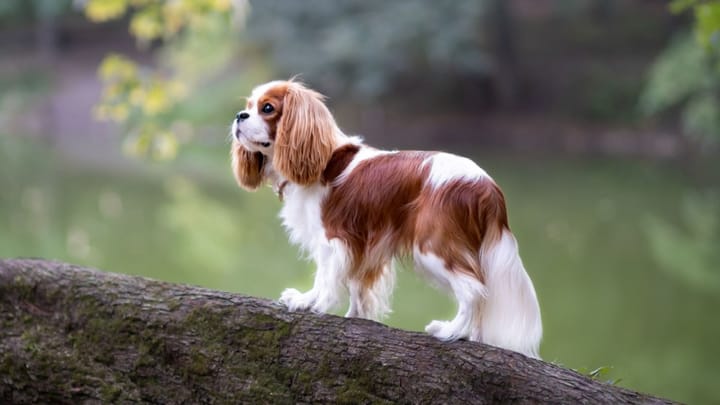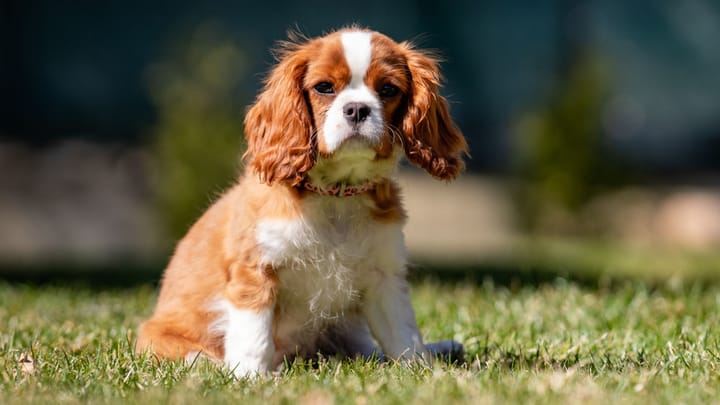Cavalier King Charles Spaniel
Other name: Cavalier King Charles


Cheerful, exuberant and full of life, the Cavalier King Charles is a high-spirited character, always on the move and looking to engage with their owner. Always eager to please, they make great pets for families and seniors.
|
Life expectancy |
The Cavalier King Charles Spaniel has a life expectancy of between 10 and 14 years |
|
Temperament |
|
|
Size |
Small
|
|
Adult size |
Female
Between 10 and 13 in
Male
Between 10 and 13 in
|
|
Adult weight |
Female
Between 11 and 18 lb
Male
Between 11 and 18 lb
|
|
Coat colour
Their coat can be black and tan, ruby (bright solid red), Blenheim (white with bright chestnut) or tricolour (black, white and tan). |
Black White Red |
|
Type of coat
Their coat is long. Cavalier King Charles have a silky coat with fringes. Their fur may have a slight wave to it but is never curly. |
Long Wavy |
|
Eye colour
They have dark eyes. |
Brown
|
|
Purchase price |
The Cavalier King Charles Spaniel costs between £730 and £940 |
The Cavalier King Charles appears to be the happiest dog in the world and is the ideal breed for those that need joy (children and the elderly). However, sometimes when they lie down to relax it can look as though they are sad. Legend has it that this is because they are thinking of their ancestors who were beheaded at the same time as King Charles I of England, a great fan of this breed and their namesake.
More details about the Cavalier King Charles Spaniel
Cavalier King Charles Spaniel: Origins and history
This dog’s origins can be traced to the King Charles breed who was once much more appreciated than the Cavalier. Today, we are witnessing a reversal of this trend because the Cavalier has fewer health problems, for example with their breathing. The Cavalier comes from crossing the King Charles, the Pekingese and the Pug. They take their name from Charles II who, according to his critics, preferred to play with his dogs rather than deal with state affairs. The breed standard was only fixed in 1928 and it was not until 1945 that the breed was recognised by the Kennel Club. As for the FCI, they definitively recognised the Cavalier King Charles in 1955.
Physical characteristics of the Cavalier King Charles Spaniel
The Cavalier King Charles is a lively and graceful dog, they are well proportioned, sporty and cheerful. Their head is almost flat between the ears and has a deep stop and they have a pointy muzzle. Their eyes are large but not prominent. Their ears are long, set high and covered in fringe. Their body is short and well proportioned. Their tail is long and fringed. Their limbs are straight and in line with each other.
FCI classification of the Cavalier King Charles Spaniel
-
Group 9 - Companion and Toy Dogs
-
Section 7 : English Toy Spaniels
Cavalier King Charles Spaniel: Characteristics
Cavalier King Charles Spaniel: Behaviour
Training a Cavalier King Charles Spaniel
The Cavalier King Charles is not hard to train, it is however sometimes hard to keep their attention.
This little dog will try to wriggle out of being trained at every given opportunity. They know how to use their charm and take advantage of a weak trainer.
On the other hand, if training is started early and a motivating reward, like food, is used they tend to cooperate easily.
Cavalier King Charles Spaniel: Lifestyle
Breed compatibility Cavalier King Charles Spaniel
Cavalier King Charles Spaniel: Purchase price
The price of a Cavalier King Charles varies according to its origins, age and sex. On average, a Cavalier King Charles registered with the KC is about £940.
The average budget needed to meet the needs of a dog of this size would be between £18 and £26 / month.
Cavalier King Charles Spaniel: Shedding
Light
The Cavalier King Charles sheds an adequate amount. When moulting it is advised to brush them every day to get rid of the dead hair.
Cavalier King Charles Spaniel: Grooming
Although you shouldn’t clip this dog, their coat does require regular brushing and detangling, at least two or three times a week.
In addition, their eyes and drooping ears should be checked and cleaned as often as possible to prevent infection.
Cavalier King Charles Spaniel: Health
Life expectancy is about 12 years.
Different to their cousin the King Charles, who is slightly more delicate, the Cavalier King Charles Spaniel is a dog that lives for a long time and seems robust…Unfortunately, the breed is predisposed to some medical complications, notably those concerning heart.
Because of their flat face, the Cavalier King Charles can struggle to breathe and regulate their body temperature. When it is very hot it is important to be careful and prioritise walks early in the morning or late at night.
This dog dislikes the cold and the damp. They are often seen dressed in a coat in the winter.
Predisposed to obesity, these dogs must not fall into a sedentary lifestyle, if so they will struggle physically.
- Mitral endocardiosis (degenerative disease of heart valves)
- Malassezia dermatitis (skin disease)
- Follicular dysplasia of black hairs
- Syringomyelia or Chiari syndrome (neurological disease)
- Dislocation of the patella
- Brachycephalic upper airway syndrome
Do you want a Cavalier King Charles Spaniel dog ?
Oh no...
There are no Cavalier King Charles Spaniel adoption profiles at the moment...






